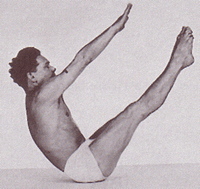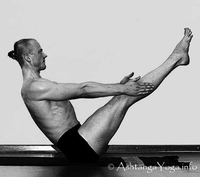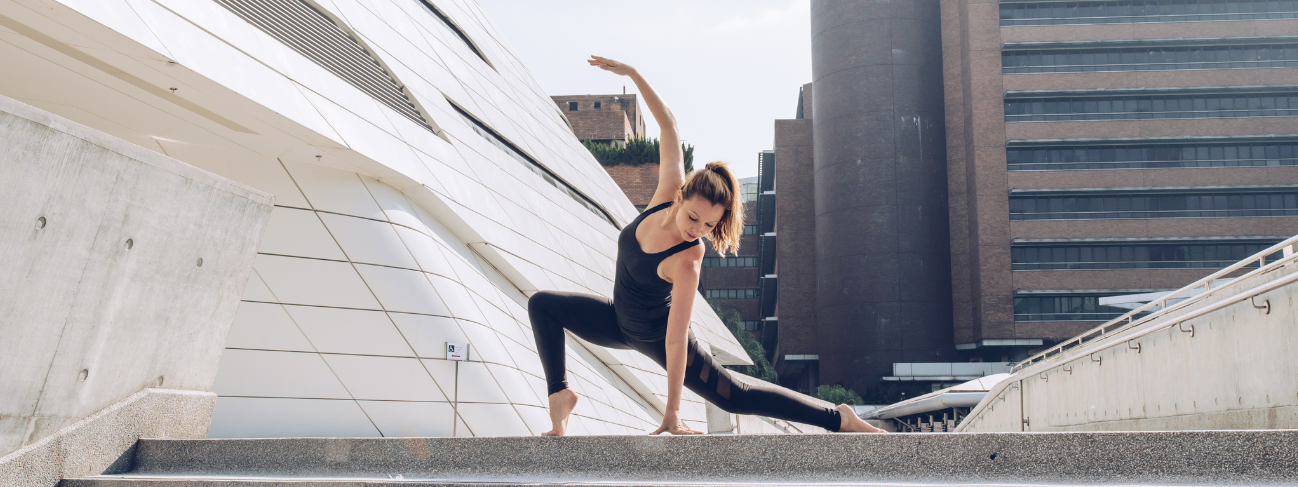29 Sep Synergise your exercise – with both yoga and Pilates
By Sherri R. Betz, PT and Heather Thomas Shalabi


Here at Flex we offer Yoga and Pilates classes as our core products. Many people ask us what the difference between yoga and Pilates is. However I believe the question should really be, “What are the similarities between yoga and Pilates?” Because when you look into the two philosophies you suddenly realise they are more in synch than you think.
You may have heard this joke: The difference between Pilates and yoga is that in yoga you close your eyes and think about god and in Pilates you keep your eyes open and think about your abs! However you look at it, it is fascinating to compare a movement practice that has been around for 2,000 years with one that’s only been around for about 80.
Core work
Most people think Pilates is about engaging the core, and it is, but in fact Josef Pilates never said we should activate the core or focus on our abs becoming hard. He talked about cleansing our internal organs and breathing – sounds like yoga to me.
Having said that, numerous yoga poses activate the core. Yoga Journal suggests that building your core naturally helps you achieve other poses and suggests dolphin plank, knee-to-arm plank, knee-to-arm chaturanga, three legged downward facing dog and the rather more advanced arm balance split.
Range of Motion
While the actual range of motion can be quite similar in both, Pilates begins with small movements progressing to end-range joint movements, while yoga holds postures nearer the joint motion and muscle length end range throughout. Some yoga teachers suggest moving to only 75 per cent of range of motion to ensure strengthening without injury.
Postures and Poses
Both philosophies include a wide range of postures and poses but this is an area in which opposing approaches both work.
Yoga often begins with a Sun Salutation, moving from standing poses first towards push ups, through numerous other asanas until the class ends in sivasana. The final resting pose is meant to help the body integrate the postures practiced.
Pilates classes usually begin in the supine positions and end with standing poses, designed as such to help the body reintegrate into functional daily activities.
Detoxification
Josef Pilates talked about a system of an internal shower. He believed you should be clean on the outside and the inside. Some shoulder girdle rotation exercises were actually designed so you could get a body brush behind you and brush off the skin cells in the hardest-to-reach places. There is an archived video of him in the shower in his skivvies nasal cleansing. There’s an obvious synergy there.
More yoga poses assist detoxification than don’t, starting with the obvious Sun Salutation, which is said to help tone the liver, pancreas, spleen and kidneys and twists which are believed to squeeze and stimulate our inner organs. Inversions may also help to clear and balance the mind while yogic breathing may also assist detoxification.
Lung space
The reason abs came into play in Pilates was because when you elongate the body your core muscles engage. You feel a natural tightening occur in the body, and over the years this was interpreted as core exercise. But back in the 40s people weren’t breathing properly and this elongation was really about creating space for the lungs.
Breathing deeply through your nose, making sure to exhale completely and pause for mindfulness between breaths is said to help cultivate lung capacity. Of course pranayama uses breathing exercises to increase prana, our vital energy, and can also help develop lung capacity.
Spirituality
Yoga stemmed from the Hindu religion and its eight limbs incorporate meditation and spiritual reflection for the purposes of achieving enlightenment.
Josef Pilates believed his ‘contrology method’ as he called it, was the complete coordination of mind, body and spirit. He believed the trinity of mind, body and spirit was necessary to achieve spiritual peace and everlasting happiness, not to mention mental clarity, zest for life and better concentration.
Yoga Bandhas
While many yoga classes don’t include bandhas, which are body locks used to prevent prana escaping the body and maximise control during challenging poses, the practice is said to hold the key to mastering yoga.
Pilates uses body locks calling the Jalandhara Bandha the Throat Chakra Lock, The Uddiyana Bandha the Abdominal Lock and the Mula Bandha the Root Chakra Lock.
Breathing
Breathing is integral to both practices.
During yoga the most common breath is diaphragmatic. The Ujjayi breath is a diaphragmatic breath identified by its resistance in the throat and therefore audible sound designed to activate the first and second chakras before rising to the third and fourth and finally moving to the upper chest and throat.
In Pilates the client is asked to maintain a deep abdominal contraction so when breathing the ribcage expands laterally. This is costal breathing and Pilates also uses percussive breathing or pulsed breathing.
Experience the ultimate synergy between yoga and Pilates at Flex’s upcoming retreat:
CLEANSE & ENERGIZE
FLEX YOGA & PILATES RETREAT
Led by Michelle Ricaille and Heather Thomas Shalabi
27 October – 1 November 2015-09-23
Kamalaya Wellness Sanctuary and Holistic Spa, Koh Samui
Read more here.
Read here about the various Pilates classes available at Flex.
And read here about all the different styles of yoga we offer.


